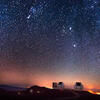You are here
CHEOPS, the Profiler of Exoplanets

The CHEOPS (CHaracterising ExOPlanets Satellite) mission, which will leave this month aboard a Vega rocket from the Guiana Space Centre (French Guiana), marks a new phase in exoplanet research. From its orbit at an altitude of 700 km, this small space telescope from the ESA and the Swiss Space Office will measure the size of these objects with unprecedented accuracy. Its twin objectives will be to learn more about the rock, gas, and even icy or oceanic composition of exoplanets, thereby paving the way for instruments to study them in detail in the years to come.



What is remarkable about this mission is that it roughly coincides with the award, on 8 October 2019, of the Nobel Prize in Physics to two astronomers from the Geneva Observatory for the discovery of the first exoplanet using the method of radial velocity. In 1995, Michel Mayor and Didier Queloz—who chairs the scientific committee of CHEOPS—analysed light from the star 51Peg using the Elodie spectrometer at the Observatoire de Haute-Provence (southeastern France). They measured its periodic variations in velocity, which indicated the presence of an enormous object disrupting the star's movement, namely a giant planet whose mass (half that of Jupiter) and orbital period (4.2 days) they successfully calculated. This first detection marked the beginnings of the entirely new discipline of exoplanetology, of which the CHEOPS mission is the latest incarnation.
After detection, characterisation
The central goal of CHEOPS is to refine the observations conducted by astronomers over the last quarter of a century. More than 4,000 exoplanets have been discovered since this first detection in 1995, thus challenging what we imagined about the diversity of these objects in the Universe, as well as how solar systems form and are organised. Still, researchers know very little about the nature and properties of these planets, which have been discovered by the hundreds, especially those whose masses range between that of the Earth and Neptune.
Are these "super-Earths" or "mini-Neptunes", which have no equivalent in our Solar System, made up of iron, silicate rock, or ice? Do they have atmospheres? If so, what is their composition? Are they entirely covered by oceans? Scientists need more clues to shed light on these questions; they would need to know the average density of these bodies in order to compare it with the internal structure of planets
Establishing a list of super-Earths
Unfortunately, the lists established to date rarely provide this information. A planet’s density is not a directly measurable value, but must be calculated by combining data regarding its mass and radius, which is collected separately and using different techniques: the radial velocity method (which uses Doppler spectroscopy to measure the slight oscillation movements of the star prompted by the mass of a planet orbiting around it), and the transit method (which establishes the planet's radius based on the drop in the star's luminosity observed when the planet "transits" in front of it). However, these techniques generally cannot be applied to the same stars. "The exoplanets for which we have established the mass using the radial velocity technique all orbit around bright (and generally close) stars, while those whose radius was measured using the transit method are usually associated with much dimmer (and therefore rather distant) stars,"explains Willy Benz, a Professor at the University of Bern (Switzerland) and leader of the CHEOPS mission.

Like CoRoT (CNES-ESA and partners), Kepler (NASA), TESS (NASA) and soon PLATO (ESA), this satellite will examine stars in order to measure the drops in luminosity caused by the transit or periodic passage of planets across its line of sight. Yet unlike these space telescopes, its goal will not be to detect new planets, but instead to observe those that have already been identified and are nearby, in an effort to determine the radius with a precision on the order of 10%. The aim is to create a list of fifty "super-Earths," all of which will be fully described in terms of orbit, mass, diameter, and density, thereby providing specialists with a sufficiently large sample to help them improve their understanding of these objects
Measuring temperature, finding rings
During the three to five years that the mission will take place, the space telescope will also monitor a series of solar systems detected using the radical velocity method, in order to determine whether they include planets in transit. Such a configuration is rare, because it means the planet crossing our line of sight of the star. Yet as the CNRS researcher from the Insitute for Planetary Sciences and Astrophysics of Grenoble (IPAG),1 Xavier Bonfils, explains, "when it is used on close and brilliant stars, it turns these exoplanets into targets whose physical properties and atmospheric composition can easily be measured". Astronomers hope in this way to discover half a dozen systems that can be observed by next-generation telescopes such as the James Webb (NASA-ESA-ESC) instrument, which should be put into service in 2021, or the E-ELT (ESO), expected in 2025. "CHEOPS will try to measure the temperature of the upper atmosphere of 'hot Jupiters,' as well as detect the possible presence of moons and rings associated with exoplanets," points out Magali Deleuil, a professor at the LAM2 in Marseille



Financed by the ESA as part of its Cosmic Vision programme (2015-2025), CHEOPS was developed, under the responsibility of Switzerland, by a consortium of a dozen countries. These included France, which did not take part in the design of the satellite's ultra-sensitive telescope, weighing 250 kg and measuring 1 metre, but did provide—through Magali Deleuil's team at the LAM—the data processing software that will be used in Geneva by the Science Operation Centre for this "S-class" (small) mission. Her team will also contribute to the choice of targets, some of which, such as 55 Cancri, already promise to generate a great deal of attention. This system consisting of two stars has at least five planets, one of which is apparently a rocky "super-Earth". This remains to be confirmed—by CHEOPS of course.



















